
Chiang Rai is the northernmost major city in Thailand, with a population of about 200,000 people. It is located in Mueang Chiang Rai District, Chiang Rai Province. Chiang Rai was established as a capital city in the reign of King Mangrai, in 1262 CE.
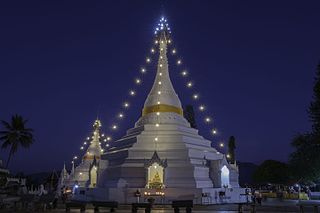
Mae Hong Son province, also spelled Maehongson, Mae Hong Sorn or Maehongsorn, is one of Thailand's seventy-six provinces (changwat). It lies in upper northern Thailand and is the westernmost province. Neighboring provinces are Shan State of Myanmar, Chiang Mai and Tak. To the west, the province borders Kayin State and Kayah State of Myanmar.

The Karen, also known as the Kayin, Kariang or Kawthoolese, are an ethnolinguistic group of Sino-Tibetan language-speaking peoples. The group as a whole is heterogeneous and disparate as many Karen ethnic groups do not associate or identify with each other culturally or linguistically. These Karen groups reside primarily in Kayin State, southern and southeastern Myanmar. The Karen, approximately five million people, account for approximately seven percent of the Burmese population. Many Karen have migrated to Thailand, having settled mostly on the Myanmar–Thailand border. A few Karen have settled in the Andaman and Nicobar Islands, India, and other Southeast Asian and East Asian countries.

Lampang, also called Nakhon Lampang to differentiate from Lampang province, is the third largest city in northern Thailand and capital of Lampang province and the Mueang Lampang district. Traditional names for Lampang include Wiang Lakon and Khelang Nakhon. The city is a trading and transportation center. Lampang lies 601 km (373 mi) north of Bangkok and 101 km (63 mi) southeast of Chiang Mai.
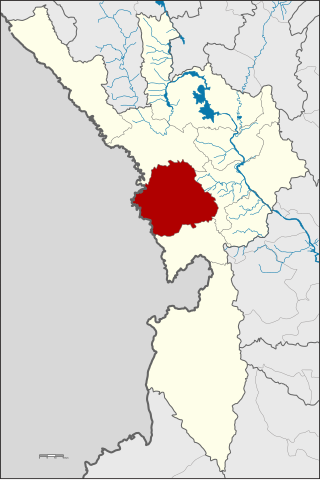
Mae Sot is a district in western Thailand that shares a border with Myanmar to the west. It is notable as a trade hub and for its substantial population of Burmese migrants and refugees. The town is part of Tak province and is the main gateway between Thailand and Myanmar. As a result, it has gained notoriety for its trade in gems and teak, as well as black market services such as human trafficking and drugs. Neighbouring districts are : Mae Ramat, Mueang Tak, and Phop Phra. The Moei River serves as a natural border between Mae Sot and the Burmese town of Myawaddy.

Cynthia Maung is a Karen medical doctor and founder of Mae Tao Clinic that has been providing free healthcare services for internally displaced persons (IDP) and migrant workers on the Thai-Burmese border for three decades.
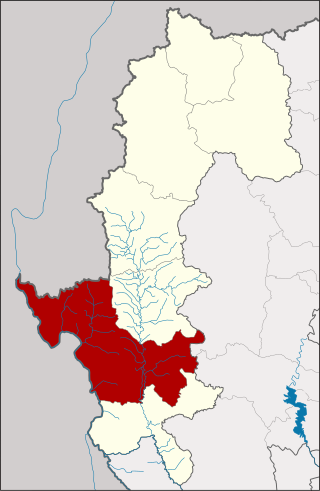
Mae Sariang is a small town and district (amphoe) on the narrow valley along Yuam River in Mae Hong Son province, northern Thailand, along the Myanmar border. The areas around Mae Sariang are mountainous and forested; flat terrain that suits population or agriculture is scarce. The local population of Mae Sariang is of mixed origin. The main ethnicity in the low land plain, town center and its satellite villages along the river is Tai Yuan with some cross-marriage with other ethnicities. There are also Tai Yai or Shan people in the town center; they are among the first groups that inhabited the area. Red Karen and Karen descendants also reside in the town with a high density in the Christian quarter of the town. There is a sizable Bengali Muslim community and a mosque near the central market. The area has many links to Burma, such as its architecture and a large population of Burmese Muslims. Mae Sariang represents the westernmost area where Lanna culture and architecture dominated which also well assimilated with Burmese/ Shan.

The Moei River, also known as the Thaungyin River is a tributary of the Salween River. Unlike most rivers in Thailand, the Moei River flows north in a northwest direction. It originates in Phop Phra District, Tak Province, flowing then from south to north across Mae Sot, Mae Ramat, and Tha Song Yang Districts, finally entering the Salween River within the limits of Sop Moei District of Mae Hong Son Province. The river is 327 kilometres (203 mi) long.
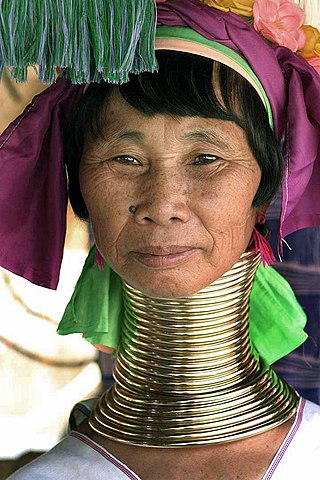
The Kayan are a sub-group of Red Karen, Tibeto-Burman ethnic minority of Myanmar (Burma). The Kayan consists of the following groups: Kayan Lahwi, Kayan Ka Khaung (Gekho), Kayan Lahta, Kayan Ka Ngan. Kayan Gebar, Kayan Kakhi and, sometimes, Bwe people (Kayaw). They are distinct from, and not to be confused with, the Kayan people of Borneo.

The Mae Tao Clinic (MTC), also known as Dr. Cynthia's clinic after its founder Dr. Cynthia Maung, is a community based organisation (CBO), which has been providing primary healthcare service and protection to community from Burma/Myanmar in Western Thailand since 1989. It is based in the border town of Mae Sot, approximately 500 km North West of Bangkok and serves a population of around 150,000 - 250,000 people who shelter in Burma's mountainous border region and, more recently, the growing Burmese migrant workers in Thailand who live in and around Mae Sot. Mae Tao Clinic has average 110,000 consultations annually. Of them 52% reside in Thailand, who are mostly undocumented and displaced due to armed conflicts or/and poverty and other 48% cross the border to seek health services.
Burmese people in the United Kingdom are residents and citizens of the United Kingdom with Burmese ancestry or origins. This can include people born in the UK who are of Burmese descent, as well as those born in Myanmar who have migrated to Britain.
Nai Soi is a small village located in Mae Hong Son Province in northern Thailand. The village is under the administration of the Thai authorities. Nai Soi is about three kilometers from the Ban Mai Nai Soi Karenni refugee camp. Nai Soi is about 20 kilometers from the town of Mae Hong Son, along a paved road accessible year-round. It is perhaps most well known for the refugee camp found there and for having the largest Karenni settlement of the three villages. Thai authorities view Ban Mai Nai Soi as a self-sustaining refugee camp.
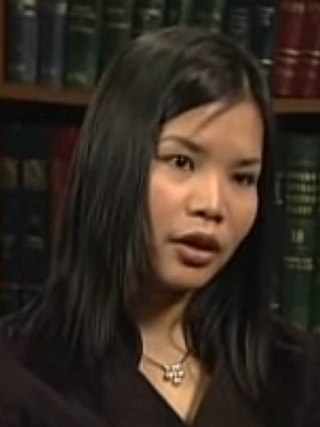
Zoya Phan is a Burmese political activist. She resides in the United Kingdom, and is the Campaign Manager of the human rights organization Burma Campaign UK. She was an outspoken critic of the Burmese government when it was under direct military rule, repeatedly calling for democratic reform in Burma, as well as economic sanctions from both the British government and the United Nations. Following political changes in the country from 2011, she has continued to campaign for international action to end ongoing human rights violations, especially regarding the use of rape and sexual violence against ethnic women by the Burmese Army.
The 2010–2012 Myanmar border clashes were a series of skirmishes between the Tatmadaw on one side, and the DKBA-5 and the Karen National Liberation Army (KNLA) on the other. The clashes erupted along the border with Thailand shortly after Myanmar's general election on 7 November 2010. An estimated 10,000 refugees have fled into nearby neighbouring Thailand to escape the violent conflict. There was concern that due to discontent with the elections, and speculations of electoral fraud, that the conflict could escalate into a civil war.

Mae La, Beh klaw ,(S'gaw Karen: မဲၣ်လးဒဲကဝီၤ, ဘဲကျီး) is a refugee camp in Thailand. It was established in 1984 in Tha Song Yang District, Tak Province in the Dawna Range area and houses 50,000 Karen refugees; the number continues to rise as of June 2019. Mae La is the largest refugee camp for Karen refugees in Thailand. Over 90% are the persecuted ethnic Karen. The camps are overseen and run by the Thailand Burma Border Consortium (TBBC), a union of 11 international non-governmental organizations that provide food, shelter and non food items to the Burmese refugees and displaced people.
Within the country of Myanmar, Ban Mai Nai Soi refugee camp is a refugee camp which was established in Karenni State in 1989, and had an estimated refugee population of 19,512 in 2008.

The Luang Prabang Range, named after Luang Prabang, is a mountain range straddling northwestern Laos and Northern Thailand. Most of the range is located in Sainyabuli Province (Laos), as well as Nan and Uttaradit Provinces (Thailand), with small parts in Phitsanulok and Loei Provinces. Several rivers such as the Nan, Pua and Wa rivers, have their sources in this range. Phu Fa waterfall, the biggest and the tallest waterfall in Nan Province, is also located in these mountains. This range is part of the Luang Prabang montane rain forests ecoregion.
On 22 March 2013, a fire at the Ban Mae Surin refugee camp in Mae Hong Son Province, Thailand, killed 37 Karen refugees from neighbouring Myanmar, as well as destroying hundreds of dwellings. Thought to have started following a "cooking accident", the fire began at around 16:00 local time, and extinguished around two hours later. The fire had been spread by hot weather combined with strong winds.

The Dawna Range, also known as Dawna Hills, is a mountain range in eastern Burma and northwestern Thailand. Its northern end is located in Kayah State where it meets the Daen Lao Range, a subrange of the Shan Hills. The range runs southwards along Kayin State as a natural border with Mon State in the west forming parallel ranges to the northern end of the Tenasserim Hills further south and southeast. The Dawna Range extends east of the Salween southwards from the Shan Hills for about 350 km, at the western limit of the Thai highlands. Its southern end reaches the Thai-Myanmar border in the Umphang area, entering Thailand west of Kamphaeng Phet. The Thungyai Naresuan Wildlife Sanctuary is in the Thai side of the range.
Umpiem Mai is a refugee camp in Thailand 12 km from the Myanmar border. It is situated on 79 hectares in the Khirirat Sub-district of Phop Phra District in Tak Province. In June 2014 it had a population of 12,900, predominantly Karen people fleeing conflict.













